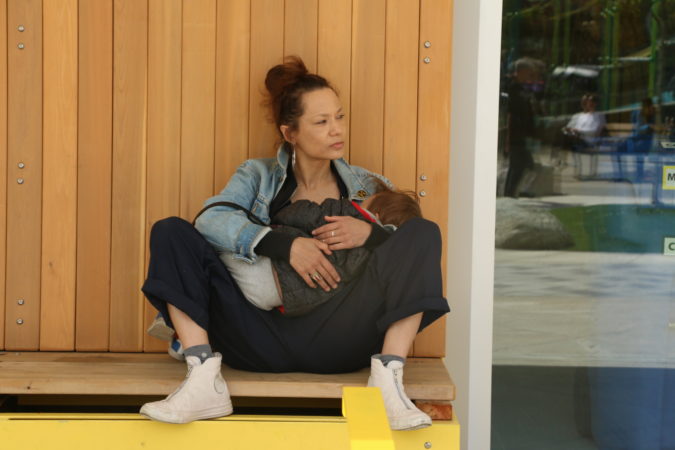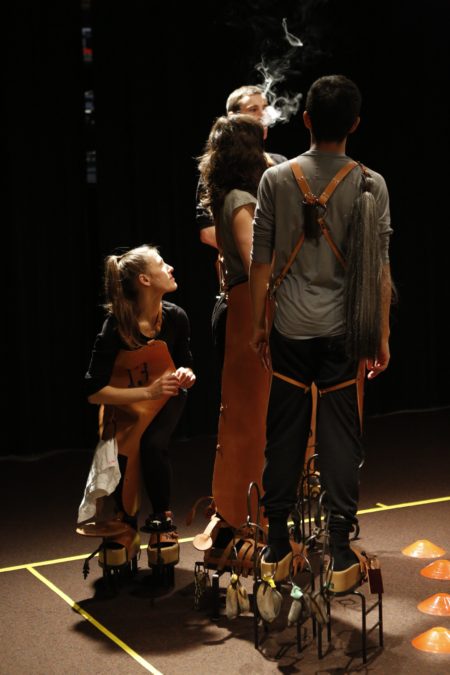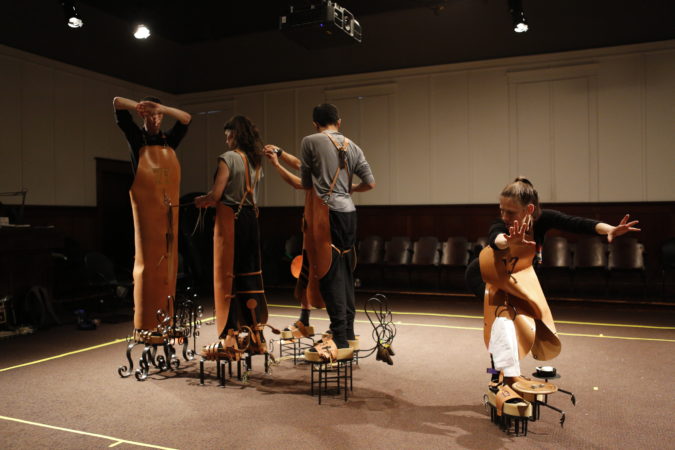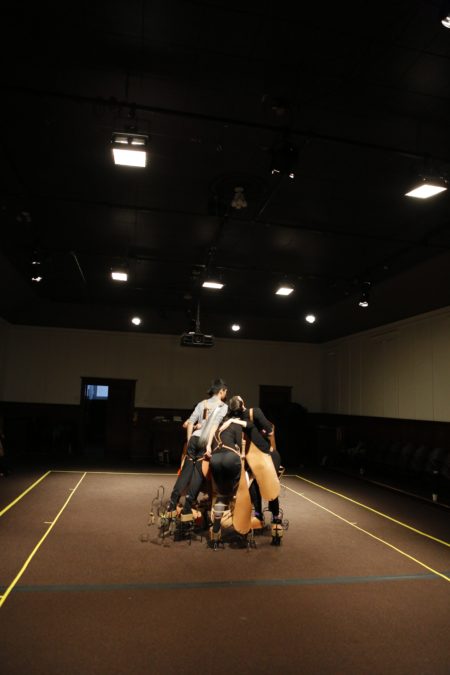PuSh In-Depth with Artist Justine Chambers: an extensive look at this artist’s creative process, multidisciplinary work, and how she sees art in Vancouver.
January 22, 2020
See Justine’s collaboration on Idealverein at The Western Front January 22-24.

Speaking with and writing about choreographer Justine Chambers, definitions feel inadequate.
Like the genre-bending nature of PuSh, the work of this celebrated Vancouver artist surpasses habits of categorization and offers a deeply considered focus that embraces and defies form.
At this year’s festival, Justine collaborates with fellow Vancouver artist Mike Bourscheid on his pre-existing Idealverein, along with six dancers (Alison Denham, Ed Spence, Ralph Escamillan, Erika Mitsuhashi, Germaine Koh, and Kate Franklin). Originally presented at the Venice Biennale in 2017 as costume-objects, Bourscheid’s work becomes a PuSh and Western Front presented performance January 22-24.
Described by Chambers as a game of fluid relationships, this version of Idealverein employs a choreographic perspective in the animation of Bourscheid’s sculptures. Chambers considerately notes that the work is Bourscheid’s; however, the joining of expertises and Justine’s unique ability to develop potent choreographic conditions seem vital to this development of the piece.
Between trips to Berlin (where Chambers recently presented one hundred more with Laurie Young), and Toronto (where she is dancing in new work by Ame Henderson), Justine sat down with PuSh for a discussion about her work, her PuSh collaboration, and her perspectives on dance and art. Connecting with a choreographer whose work regularly disregards presentational norms, and dwells across the realms of dance and visual art (not to mention writing and music), seems to touch on something central to the PuSh experience.
PuSh: One of the values, if not the central theme or tenet, of your work seems to be the significance and potential of everyday movement. It also seems that you develop work through attention to the choreography that is inherent in the body and the human condition. Can you talk about your background or how you arrived at these interests?

Justine: When I started making work, initially I would try and make virtuosic dance moves, but the things I always loved were these moments of tiny movement, tiny dances, that just felt like living. I think as I continued to develop a choreographic practice, incrementally over time, I just resigned myself to the fact that I don’t make those kinds of dances, I just like illuminating the ones that are already there. And I think this really has a lot to do with empathy and a great desire to be with people, and knowing that when we feel each other something really special happens, I would argue much more so than when we see each other or hear each other. So maybe it’s also this call out for togetherness.
Also I’m a diplomat brat, so we moved a lot. I’m also mixed race. So I always feel like I am in-between, like I’m neither here nor there. I exist in that place. I think I spent a lot of my childhood and a lot my life walking into a room and really observing and feeling the tension in the space, or the ease, and seeing how people fold their bodies and then adapting to slide in – when you’re the new kid and not the white kid, this is the kind of work you do. I can recognize that I’ve always done that. I’ve always been in this act of observing choreography of the space, or an interaction, or how groups of people move together, and then adapting my body in relationship to that. So I kind of feel like I’ve been practicing this my entire life.
I think as time has gone on, further, I’m always trying to think about how I can really activate choreography as a sort of empathic practice in life. So how can the things I make or the situations I attempt to put into motion, through different scores, be a way for us to feel each other and not be . . . It’s so easy for us to separate ourselves because of time, because of money, a million things. But I just think if you could feel me, if I could feel you, maybe I would think differently – the cognitive machinations of my mind would think differently about being with you.
I also think this accumulation of working with the everyday, or actions that happen all the time, is also about, over the course of my life, incrementally building an embodied archive. I question how archives are assembled and kept and I think historically those archives are kept within white supremacist and colonial structures (that rule the world). I can’t help but ask “What would another archive look like?” And there’s something important for me, about thinking of my body, and the bodies of people I’m working with as an archive. Dance, in this way, is a very practical method of archiving. I’m interested in continuing to develop these other kinds of archives – a way to catalogue experience in the world that’s not always given space, or weight, or time.

P: How did you connect with Mike Bourscheid? How was the Idealverein collaboration with him initiated?
J: Mike and I were both in a group exhibition at Haverford College called Unwilling: Exercises in Melancholy, curated by Vanessa Kwan and Kimberly Phillips. I arrived there, where I was going to perform the score ten thousand times and one hundred more, and Mike had a work there too. The day everybody was working on their install they announced there was going to be a snow storm and they needed everybody out so we all got holed up in our hotel. Me and Mike, and Noa Giniger sat in out hotel lobby and talked for 8 hours, and it was the most lovely encounter, and we talked about everything and nothing, fashion, art and film . . .
And Mike’s work was like nothing I’d ever seen before, and I was like “what is this guy on about it?”
[Afterwards, Mike] wrote me and said he had these sculptures – that were at the Venice Biennale. It’s a series of shoes and aprons and he had always wanted to make a performance out of it, and he knew what he wanted to do. He wanted me to work with him on it because he saw it as a choreography. He asked if I would work with him And it was a no brainer. I knew I wouldn’t be there for the shows, but of course I would do it.
P: What was the process like of developing this work into a performative situation (if you would call it that)? Can you talk about your creative process with Mike?
J: It’s definitely his baby but he’s so open for me to push up against it.
I really love that we’re both able to be so clear, and really hear the other person out but still make our own decisions. I really feel like I’m there to support what he wants to do and he is very clear about what it is. Because of that it’s easy for me, in a way. At a certain point I thought I needed to do more but that’s a bad personality trait of mine. . . and he acknowledges that I see things that he doesn’t.
It’s one of these art university moments. You get to go and you just learn a ton from what someone else is working on. And he has such a beautiful heart – I can’t say enough about that.
He has a reverence for dance and works with performance, and his work is an amalgamation of so many things.
I would never think to do what he’s doing, so it is such a delight to be in the room. He is offering all the simple and complex ways we can be together and that’s the game. I love that way of thinking. Where we’re the same is what we’re offering. It’s a game where all the characters are continuously working between between being for, against and with. I see him thinking about support with these beautiful, outrageous costume- sculptures and these different ways to support: intellectual, physical and strategic support, which is something I’ve been thinking about lately when I teach. He has made me think about support in a new way.
And I think there is something unfixed in the work which is very much how I work as a choreographer. A set of conditions that we work through and in every performance something different happens. The rules and tasks don’t change, but the outcome is changeable. We’ve worked with each dancer to see how the shoes and aprons can affect what they do and asked the question: if this was the only way you could move how would you live a life?
P: Your work often lives between and through the space of dance, and visual art. Could you talk about your way into crossdisciplinary practice and the value of working across genres?

J: My partner, Josh Hite, is a visual artist. When he was at UBC I started hanging with his people, and my choreographic interest intersected with a kind of resurgence of dance in the museum scene. Sometimes I wonder if my work straddles the two [disciplines] or if my timing straddles the two meeting again.
But, being invited into visual art spaces frees me in a way that I am not free in dance spaces. All of a sudden, I think that I get expansive about how I think about choreography and dance. I’m not in a dance room and all of the sudden I feel like I can decide.
So I think it’s a bit of timing but also a bit of being embraced. There has been something about the way I’ve been supported to work within visual art spaces which is different than dance.
P: What do you see as the value of interdisciplinary collaboration?
J: I guess, for me, I just think about collaboration as something that neither of you would make on your own, but – something else. So it’s a kind of a great moment to release your ego in one way and really hold on to it in another way. And it’s a way to know what’s important to you, because when someone says no to something you can say “Wait, I’m not letting go of that baby”.
My partner and I do a few projects together, and we have ongoing projects which are things we do again and again. And we talk about the idea, and then we work on the idea not the discipline. What’s the idea and what’s going to make the idea arrive? So it may be capital D dance or theatre, but it very well may not be.
The work that speaks to me is when the thing they say the work is on about is actually what it’s on about – so less illustrative or representational, but when the work is the thing you’re doing – and that’s always been what guided my process. For me, that’s become how I’ve distilled how I’m going to work.
So if you’re a choreographer or dancer, that’s the lens through which you’re going to see the world, but it doesn’t have to manifest in a way that dance has been prescribed before you or before this moment.
P: What might be the value of interdisciplinary work for audiences?
J: I had this moment a few years ago where someone said to me, I really like music and film and art, but I just don’t like dance. And I wondered “How do you know that you don’t like dance, and can we get more precise about what you don’t like?” And sometimes I think when collapsing forms or working multi-disciplinaryily, maybe that allows people to understand another aspect of that thing that they thought they didn’t like.
P: What is significant to you, as an artist, about PuSh?
J: One thing that I really love about PuSh is that it brings people to the city who I want to meet : this is a gift – to connect artists to each other in the city. This time I get to see my friends at PME Arts perform the DJ (Who Gave Too Much Information). My friends come to town and I get to see them do their thing and that’s really exciting to me. It’s glue amongst artists. . . I talk about being more concerned with the how than the what, and this connective power, the conversation, offering someone a home-cooked meal . . . , is part of that.
Also, sometimes when you’re on the other side of the mountains on the edge of the world, you kind of miss a cohort of artists and because of the connections that PuSh, that network of presenters brings the people to the city.
P: What do you want to communicate or offer to audiences through your work?
J: In terms of what I want to offer an audience, I’m not concerned about doing something for the audience, in this moment of my life, (and I could change my mind next week). If I spend my time worrying about what you want, then I’m not doing my work. I’d be doing the work that I think you want and I can’t possibly know what that is.
Maybe there’s a way of being together that I can offer through these dances that I’m making. But when I’m in process, I can’t occupy myself with it working for you, because again, if I get concerned with that I’m not working on what’s important to me . . .
I hope that audiences get curious. I guess that’s it. I can’t solve anything.
P: How do you see your work as significant in a larger social or political context?
J: This is a good question. Being political is inextricably linked to what I make. We make what we are, we make what we know. Recently I made something that is pointedly political, One hundred more in Berlin (with Laurie Young), centred on gestures of resistance specifically as women, specifically as POC.
I don’t think that I have anything new to say, to be honest. But I think that my experience is only my own and specific, and I think I can be vulnerable enough to share that. And I think there’s something about having a desire to disarm. I’m a big nerd just like everyone else, and I think if I can be willing to be vulnerable, which may be a strength of mine. . . I feel ok with being vulnerable in performance, and in my teaching, and in my relationships. Again, it can be about a place to meet, an alternate place to meet. Ashon Crawley, this beautiful scholar and artist who is referred to as a black pentecostal queer theorist – he talks about the “Otherwise” as being another mode of being. His words echo through my brain and through my body all the time.
[Thinking about] the black side of my family (and with both my parents) dancing is a way of being together. This kind of togetherness is a way to be outside of some of the more oppressive structures that are present. I made a project with my grandmother last year where I made line dances based on the dances that she did when she was a teenager and young adult . She described them to me over the phone. For me that feels very political. My grandmother is 90 so she lived in a time where her humanity wasn’t considered. So for me to let her body be shared, and insisting upon on her presence, through sharing her dances and doing them together over and over again . . . It does something. Moving together does something, we know it does.
P: You’ve lived in Vancouver since 2006, but you also travel a lot. From the perspective informed by that experience, how have you seen the art and dance scene evolve in Vancouver, and what do you see as distinct or significant about the scene here?
J: What happens is that every community changes over time because young people are amazing and they bring new ideas and new perspectives and new approaches. Part of the beauty of youth is that being naive allows you a certain kind of freedom. Once you get established you can kind of get bunged up in your own mythology. And so there’s this beautiful thing comes with emerging artists where they arrive with fresh air.
I feel in this moment, the dance community here excites me to no end. Having gone to a number of other places, it’s clear to me there is good, bad and in between wherever I go. . And I think we’re so Eurocentric in terms of dance, around value. And ya, there’s great work happening in Canada.
And in Vancouver there’s a cohort of maybe mostly modus [operandi] and SFU [grads], maybe between 28 and 32 right now, and they’re so interesting and so progressive, and so vigilant around ethics in their practice. I find myself wanting to invite them into my projects, in the ways that I can because they make me feel energized.
I’ve also been warmly welcomed by the visual arts community in this city where there have been, in particular some outstanding artists and curators who kind of changed me in the way that they work, because of the way they care. And holy – they have nailed it..: like Bopha [Chhay] at Artspeak, Vanessa Kwan who’s at grunt gallery, Kim Phillips who’s at the CAG, Cheyanne Turions at the Audain and Allison Collins at the Western Front. These women are a big deal to me – I feel like they embrace and place value on process and thought as much as objects and formal performance. This idea of working through is the work. Valourizing that as a way of being in art has been super validating, but also rich and fertile ground. There’s a peer mentored, insisting upon, and a being in the state of constant learning that is expansive.
There’s also the senior dance artists here who are always making new work and have shepherded the dance community in such an extraordinary way. I think about Peter [Bingham], I think about Jennifer [Mascall], I think about Barbara [Bourget] and Jay [Hirabayashi], I think about Su- Feh [Lee] and David [McIntosh]. They are some of the people who have built the dance community for all of us to springboard from.
And then there’s the mid-career and late mid-career artists. They are simultaneously having companies, running spaces, curating and coordinating performance platforms, hosting training intensives, having families, initiating national and international collaborations, teaching, performing in the work of others and touring….it’s heroic.
I think the dance community has changed a lot in the time that I’ve been here but I think that communities are always changing because there will always be a continuous mushrooming of young artists in dialogue with the established ones. . I feel like there’s genuine intergenerational exchange in our community right now and it’s wonderful.
Click here for Idealverein tickets and more show information.
Idealverein Photos by Gil Goletski. Dancers: Alison Denham, Ed Spence, Ralph Escamillan, Erika Mitsuhashi, Germaine Koh, and Kate Franklin
Story and Interview by Heather Myers, PuSh Festival Intern